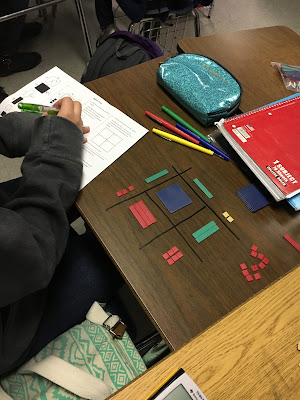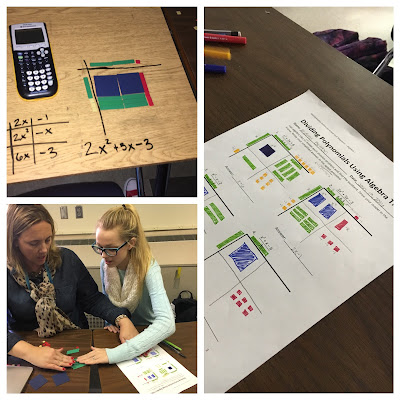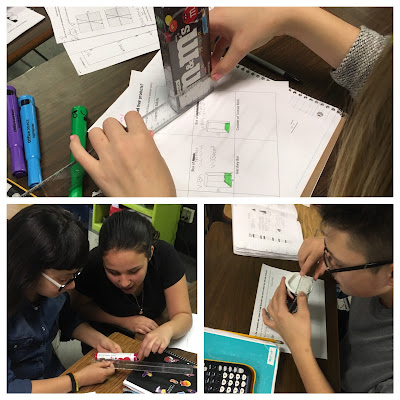As a new year begins I can't help but be more excited for what the coming months hold for the learners of Room 27! Despite having to take "the" test in a few months, we have so much learning still to conquer. After all our Falcons are soon to be Richland Rebels, where doors will continue to open to learning opportunities. Opportunities in the classroom, on the field and in life!
The past few months have re-ignited a love of teaching, learning and growing. Loves that were lost amongst the everyday routines, placed on a bookshelf, filed away into a Google folder and forgotten about. Through relationships with the other teachers and leaders on my campus, a spark was ignited and a passion was instilled.
Model what You Want to See from Others
It's crazy to think who you surround yourself with impacts all aspects of your life! I have found when surround by positive energy, my mindset changes to getting to go to work, rather than having to go to work. I am continuously reminded of the why behind each day when I look into the hearts and souls of the learners of Room 27. School provides much needed stability for some of our kids. It's hard for me to hear students talk about how teachers don't like their students or don't seem happy to be at work. Not only are kids absorbing our actions, words and thoughts, but so are fellow teachers and parents.
Have Students Help Set Classroom Expectations
At the start of our school year, each class wrote mission statements! I find myself reading them but wonder if the kids are taking time to truly understand what our mission statements mean. I am going to be intentional with our conversations, while referring back to our mission statements, throughout our spring semester. The spring semester is usually hectic, filled with stress as we approach testing season. I want to emphasize the learning we are doing is not for a test, but rather to make us global citizens, who are college-ready.
Learn 3 Things about a Student a Week
This goes hand in hand with our goal setting conferences that a few of us teachers are going to participate in together! Though I don't teach all of the kids we will meet with over the next 6 weeks, I wouldn't miss the change to get to know them, both as a member of our school community, but also a person. After all, the more accountability we can provide our kids and each other, the more success we will achieve!
Celebrate!
Embracing a growth mindset has been vital to seeing the small victories that occur in a classroom! In the "traditional" classroom, you get one opportunity to prove how smart you are with a unit assessment. I have embraced the philosophy that every day we are faced with learning opportunities, not just an assignment. Our learners are still trying to grasp the idea of being able to make corrections on any assignment, rather than just ones with a "failing" grade.
Thank Somebody Daily

Gratitude has empowered me to teach more effectively, appreciate my individual students, grow in my profession, and enjoy life. Utilizing gratitude, I am able to model one of the most important lessons in life, having a positive attitude, especially about the aspects of life that challenge me.
 |
| @Lindseycato1 Gratitude Journal |
I know several who keep a gratitude journal, focusing on finding one thing they are thankful for each day. I think this is vital to our well being and making the most of each day.
On social media, I'd encourage you to begin posting & searching #ThankfulThursday...it's contagious!
5:1 Ratio
5 positive interactions to every 1 negative interaction. One of the best pieces of advice I've been given is to write everything with a positive tone. For instance, instead of saying "but," use "and"; saying "our classroom" rather than "my classroom" ; saying please remember, instead of don't forget...simple ways to turn our thinking into a positive mindset!
Learn a New Way of Teaching, then Try It!
A friend of mine asked me to mentor her, which was a huge honor. The craziest part is I think we are mentoring each other to be better teachers for our learners.
 |
| One of the best books to transform our practices |
Read a Professional Book
I'm guilty of taking advantage of our Amazon Prime account and having new books shipped weekly! Thanks to my PLN, I'm constantly getting new book titles to read. As we start 2017, I'm going back and rereading a few of my favorites, along with some of my teaching friends. The joys of reading, is you can always learn something new!
Now I anxiously away for the books to arrive and the learning to continue!
Make a Class Mantra
- We want our learners to care about problems they see in the world, acknowledging our desire to have empathy become the anchoring force in our learning community.
- We want our learners to think deeply about the problems, coming to an understanding of what each problem really is.
- We want our learners to use their creativity and imagination to design something (an object, process, or system) that could solve the problem.
- We want our learners to act toward putting their design into production, whether that meant creating a physical prototype to present or a behavior that they or others can exhibit.
So how can we take the 4 ideas that we want and turn them into a mantra? I plan on asking our learners what they think our class mantra should be, after all it's not my classroom, but our classroom!
Share Your Hidden Talents
Honestly, this is a challenging concept for me! I think back to a few years ago when we had club time on Friday afternoons. I was able to share my love of scrapbooking with about 25 students. Even the few times during the past few months when I pulled out my Cricuit and showed the kids how to use it, they thought it was awesome!
This spring, I hope to share my love of Excel with my students, as well as creating digital presentations as we embark on our first PBL, focusing on STEM careers and financing our higher level education. Stay tuned for more hidden talents to be shared with the learners of Room 27!
Encourage Parent Participation
I am a strong believer in keeping parents involved in the happenings of Room 27. In fact, I still send weekly emails home so parents know what we are doing in class. Sure there are concepts that are abstract, but that's where parents can ask their children about it and conversations can take place at home.
This past fall, we embarked on digital goal setting. After meeting with each learner, he or she had to go home and discuss their goals with their parens, providing digital documentation!
 |
| Mother Son Goal Setting |
 |
Father Daughter Goal Setting
|
After we were finished, I shared the following survey with the parents: A Parent's Perspective on Goal Setting I would have loved more parent input, however, I'm grateful for the feedback I did receive. We will be revisiting our goals throughout the next semester, which I hope will allow parents to continue to feel apart of our journey!
 |
| Goal Setting Coffee Dates with Mom |
Remember, even in middle school, parents love hearing from the teachers and being involved in their child's learning journey!
Recognize Positive Behavior-Reinforce It-Rinse-Repeat!
Focusing on the positive actions of our learners is huge in not only their success but the overall feel in our classroom!
Too many times we are quick to call out students for what they are doing wrong, rather than the behavior that is modeling positive consequences. (Remember focusing on the positive for 2017!) I am a strong believer in either emailing parents or calling when their child is doing well academically, working to their full potential or being a good role model for their peers. Not all communication home has to be about academics!
Greet Parents & Students as They Arrive
One of my goals during the first week of school is to know each child by name. Sure I may make mistakes but what kids see is that I am trying. By greeting the learners of Room 27 by their first name shows them that I respect who they are and the story they each tell.
When my teaching schedule changed in October from 3 classes to 5 classes, I quickly knew I had to create a connection with our Algebra kids. Change is hard as an adult, but even more challenging as an 8th grader! Within 3 days I had most names and faces connected, which was a new personal record.
I encourage you to also speak to your coworkers in the hallways. A simple good morning or how are you can make somebody smile and brighten their day! Be the reason others smile :)
Make Sure Student Voice is Valued
For the past two years, I have used surveys both as formative assessments and summative reviews of our units of study. Here is a link to one:
A Student's Perspective: Your Voice Matters The information collected from these surveys helps me be more intentional with my instruction and meet the needs of our learners.
My goal for 2017 is to allow more student voice in how our classroom operates. I'm currently working on my STEM certification and one of the indicators focuses on student voice in how the rooms looks (furniture set up).
I am already looking forward to seeing the impact this has on our learning environment. Stayed tuned for details!
Give 100% Effort
The why behind my career...I get to learn along side some of the best people around! By putting for 100% each day, I feel productive and successful, even if I hit an obstacle in the road. When I'm not 100% engaged into our day of learning, I find that the day just drags. Learning is monotonous and I can't wait until 4:15 so I can leave school. Honestly, I've had only a few of those days this year, which I am beyond grateful. I hope to continue being encouraged and supported to give 100% each and every day!
 |
| The Why to Each Day |
Recognize the Small Wins
This is where my goal of reflecting on each day is going to serve as my reminder of what small victories each day holds! I'm grateful for the joy writing brings me and can't wait to continue documenting our journey in 2017
Go All In!
Stay tuned for the incredible learning and growth that happens in Room 27 this semester. We are looking forward to sharing our growth with you, as we prepare for life beyond the 4 walls of our classroom!































































